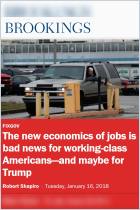Melden Sie sich bei getAbstract an, um die Zusammenfassung zu erhalten.

Melden Sie sich bei getAbstract an, um die Zusammenfassung zu erhalten.
David H. Autor
Work of the Past, Work of the Future
NBER, 2019
Was ist drin?
The US labor force has morphed dramatically since the 1980s.
Recommendation
Technology, globalization, demographics and the rise of the gig economy are just a few of the factors that have changed the US labor market. Professor David H. Autor examines the current American job environment in this eye-opening report. He assesses why real wage growth for the non-college-educated employee has shrunk dramatically, while college-educated workers have seen pay increases. Labor specialists and hiring managers will appreciate this insightful study for its thorough appraisal of wage inequality, labor market conditions and US work dynamics.
Summary
About the Author
David Autor is an economics professor at the Massachusetts Institute of Technology.























Comment on this summary